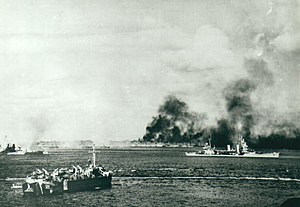Battle of Angaur
| Battle of Angaur | |||||||
|---|---|---|---|---|---|---|---|
| Part of World War II, Pacific War | |||||||
 |
|||||||
|
|||||||
| Belligerents | |||||||
|
|
|||||||
| Commanders and leaders | |||||||
|
|
|
||||||
| Units involved | |||||||
|
|
||||||
| Strength | |||||||
| 10,000 | 1,400 | ||||||
| Casualties and losses | |||||||
| 260 killed 1,354 wounded |
1,350 killed 50 captured |
||||||
The Battle of Angaur was a battle of the Pacific campaign in World War II, fought on the island of Angaur in the Palau Islands from 17 September—22 October 1944. This battle was part of a larger offensive campaign known as Operation Forager which ran from June 1944 to November 1944 in the Pacific Theater of Operations, and Operation Stalemate II in particular.
Angaur is a tiny limestone island, just 3 mi (4.8 km) long, separated from Peleliu by a 7 mi (11 km) strait, from which phosphate was mined. In mid-1944, the Japanese had 1,400 troops on the island, under the overall command of Palau Sector Group commander Lieutenant General Sadae Inoue and under the direct command of Major Goto who was stationed on the island.
The weak defenses of the Palaus and the potential for airfield construction made them attractive targets for the Americans after the capture of the Marshall Islands, but a shortage of landing craft meant that operations against the Palaus could not begin until the Mariana Islands were secure.
...
Wikipedia
